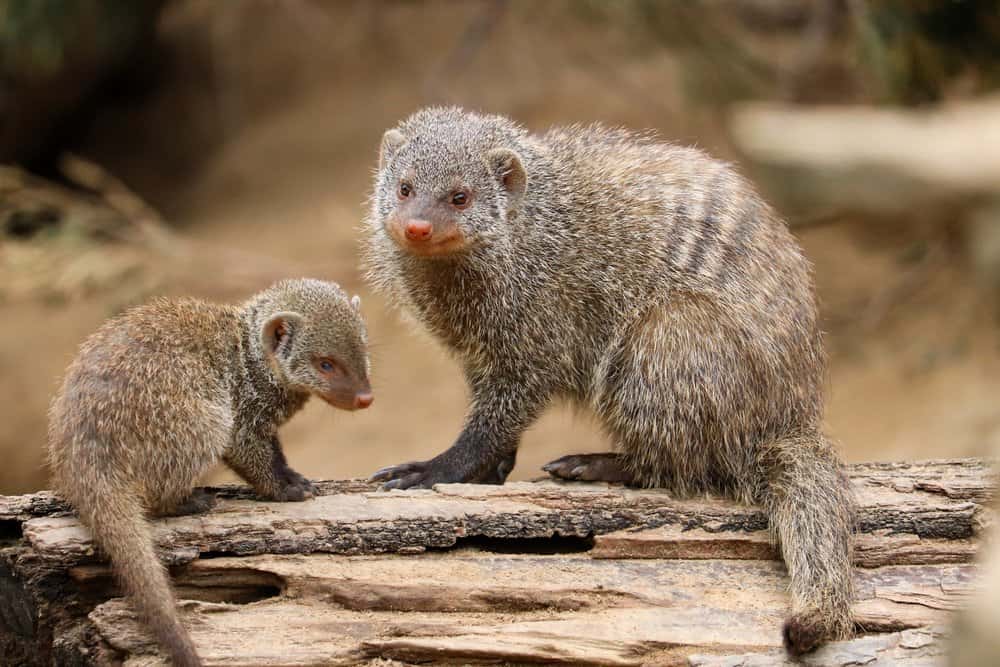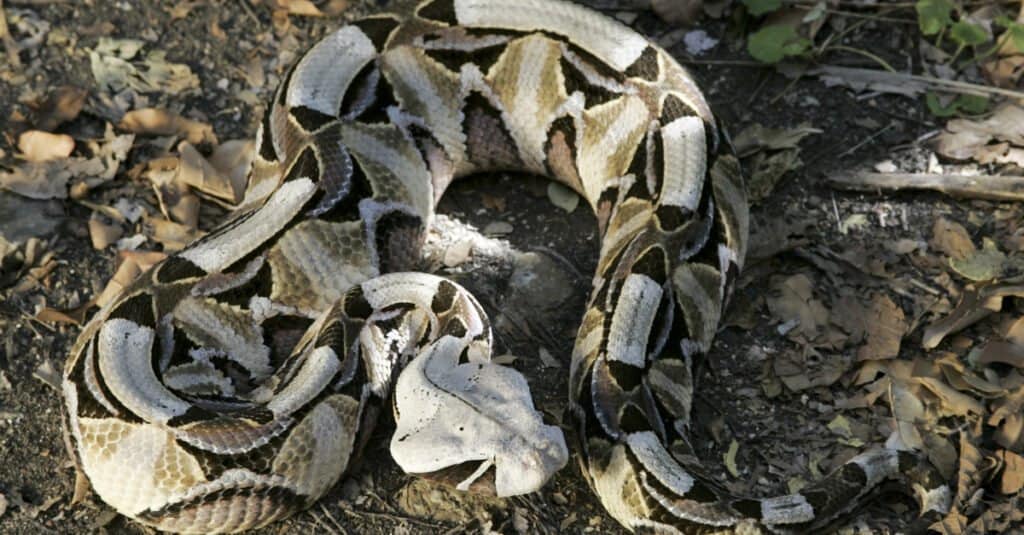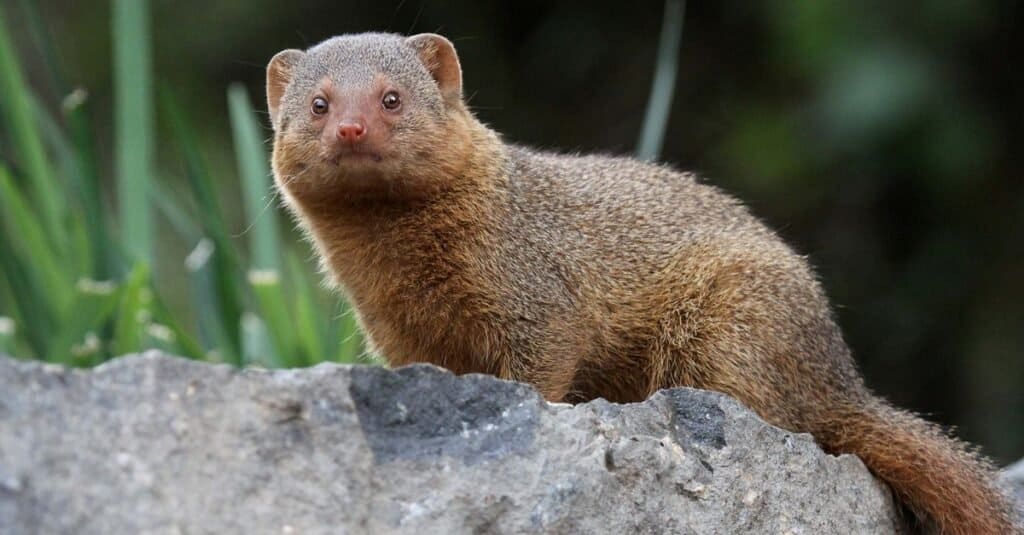Venomous snakes are very effective at killing small mammals. Every once in a while, snakes find their matches in the form of a warm-blooded creature. In this case, we’ve come up with a mega-fight between the snake with the longest fangs and largest venom yield of any venomous snake and a mammal that has the perfect biological toolkit to kill those slithery creatures. Today, we’re going to look at a fight between a Gaboon viper and a mongoose to see which animal has the better chance to live!
Comparing a Gaboon Viper and a Mongoose

| Gaboon viper | Mongoose | |
|---|---|---|
| Size | Weight: 10lbs-45lbs Length: 4ft-7ft | Weight: 5lbs – 11lbs Length: 0.8ft-2.5ft |
| Speed and Movement Type | – Less than 5 mph – Known for being sluggish and slow-moving | – Up to 20 mph – Runs with a gliding gait, head low to the ground. |
| Defenses | – Colors allow it to easily blend in with the forest floor – Size makes the snake harder to take for typical predators | -Thick fur that deters bites and holds – Very high speed and agility help this mammal dodge very fast attacks – Limited resistance to snake venom |
| Offensive Capabilities | – Incredibly fast bite at 75 to 200 mph – 2.2-inch fangs, the longest of any venomous snake – Delivers massive amounts of venom because it doesn’t release after biting – Cytotoxic venom that is not highly toxic but enhanced due to volume – Delivers between 200 and 600mg of venom per bite | – 28 teeth – 4 powerful incisors capable of breaking bones – Powerful sense of smell used to find burrowed prey – Good sight during the day – Very good hearing used for hunting. |
| Predatory Behavior | – Ambush predator that waits for prey to get very close to it before attacking | – Some species hunt alone, others together – Pursuit hunters |
What Are Key Differences Between a Gaboon Viper and a Mongoose?

The mongoose might not look deadly, but it’s a vicious hunter.
©Cassidy Te/Shutterstock.com
The biggest differences between a Gaboon viper and a mongoose include their morphology and size. The Gaboon viper is a limbless reptile with a large, leaf-shaped head featuring two small horns above its nostrils that measures up to 7 feet long and weighs 45 pounds. A mongoose is a small quadrupedal mammal with a thin snout, long body, and rounded ears that measure 2.5 feet long and weigh 11 pounds at its largest.
The size disparity may seem large, but the mongoose is known for punching above its weight. Let’s see how these two creatures would clash in greater detail.
What Are the Key Factors in a Fight Between a Gaboon Viper and a Mongoose?

Gaboon vipers can blend in with leaf litter.
©Stu Porter/Shutterstock.com
The key factors in a fight between a Gaboon viper and a mongoose will boil down to speed and power. However, we need to look at five different facets of these animals to determine who has the advantages in these areas and others. We will examine five total elements that will tell us all we need to know about this battle.
Gaboon Viper vs Mongoose: Size
A Gaboon viper is larger than a mongoose in terms of length and weight. The largest Gaboon vipers can measure up to 7 feet long and weigh 45 pounds. However, the biggest mongooses will only weigh about 11 pounds and measure up to 2.5 feet long.
Gaboon vipers have the size advantage in this fight.
Gaboon Viper vs Mongoose: Speed and Movement
A mongoose is faster than a Gaboon viper. The maximum speed of a mongoose is about 20 miles per hour, and they run with a low, gliding gait, keeping their head close to the ground. A Gaboon viper can move at speeds of less than 5 miles per hour, and it is known for being a slow, sluggish reptile.
The mongoose has the speed advantage.
Gaboon Viper vs Mongoose: Defenses
The mongoose has better defenses than a Gaboon viper. This mammal has thick fur that will help deter bites and holds as well as a limited resistance to snake venom in some cases. Moreover, it has great speed and agility to dodge attacks, even those from the dreaded king cobra.
The Gaboon viper has the benefit of a color pattern that helps it blend in with the rainforest floors, as well as a large, leaf-shaped head that makes it hard to see. Moreover, the snake’s body is large and thick, making it harder to attack successfully. This snake has few, if any, natural predators.
The mongoose has the defensive advantage in this case.
Gaboon Viper vs Mongoose: Offensive Capabilities
The Gaboon viper has the longest fangs of any venomous snake at 2.2 inches as well as the highest venom yield of any snake in the world. While its cytotoxic venom is not counted among the deadliest out there, it’s still potent. Also, this snake has one of the fastest bites of any reptile!
The mongoose is a very straightforward attacker. This creature chases down, harries, and waits for the perfect moment to deliver a fatal, skull-breaking bite. And it can do just that with its four powerful incisors, the ability to smell prey that is burrowed, and enhanced speed and agility.
Both creatures can end the fight in a single bite.
Gaboon Viper vs Mongoose: Predatory Behavior
The Gaboon viper is an ambush predator that waits for prey to get close before delivering a lightning-fast bite. It does not let go when it bites its prey, though. It holds them and delivers massive amounts of venom to their system.
Mongooses are opportunistic pursuit predators that hunt others. Sometimes they hunt alone, and some choose to hunt together.
The Gaboon viper’s ability to attack from a hidden position gives it an advantage.
Who Would Win in a Fight Between a Gaboon Viper and a Mongoose?

Mongooses are noted for their audacious attacks on highly venomous snakes, such as king cobras.
©steve bushman/Shutterstock.com
A mongoose would win a fight against a Gaboon viper. The Gaboon viper is too easygoing and slow for its own good. It is a docile snake unless it is hunting or fighting other males during the breeding season. Mongooses can be very hostile, so they would charge into this battle prepared to overwhelm the otherwise slow-moving creature.
That’s not the only factor that matters in this fight, though. A mongoose has a very powerful bite combined with the speed and agility needed to get close and dodge a snake’s opening salvo. This happens all the time with other snakes.
Yet, the Gaboon viper has a very fast bite that sees it moving at speeds so fast that it’s hard for a human to track them. If the viper landed a bite and didn’t let go, the mongoose would be in trouble. However, the sheer speed difference, specialized tools the mongoose has for taking out snakes, and the ability to land that first blow against a creature that may not realize it’s in danger until it’s too late shows that the mongoose has a great chance of surviving.
The only major unknown of this fight is whether the large head of the snake would be a unique obstacle in the battle. Based on the outcomes of a mongoose against other snakes, the mongoose should not have any problems. The Gaboon viper’s head is larger, but the skull is not abnormally thick. A quick bite and a rapid snapping motion would probably kill it.
Of course, a hungry Gaboon viper in hiding could land the first strike, and it could be fatal in two ways. Its long fangs could puncture organs and then flood the creature with venom. In that hold, the mongoose could counter and do some damage to the snake, but the mammal would end up dead.
Overall, though, in a one-on-one battle, the mongoose has a better chance to win.
The photo featured at the top of this post is © Danita Delimont/Shutterstock.com
Thank you for reading! Have some feedback for us? Contact the AZ Animals editorial team.






